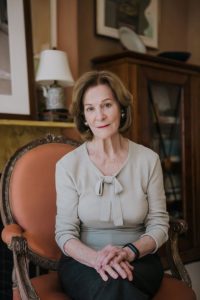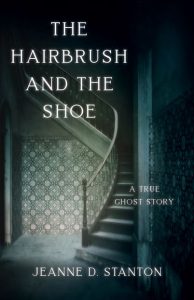The Hairbrush And The Shoe: Road To Publication
Road to Publication:
 The Hairbrush and the Shoe began as an account of a series of bizarre incidents that convinced me our 1875 house might also be home to a ghost. A hairbrush disappeared from a mantel and reappeared in a desk. Laundry was folded on a day no one was home. A cast iron bed moved out from the wall. Was it a ghost? Did ghosts even exist? I had to find out.
The Hairbrush and the Shoe began as an account of a series of bizarre incidents that convinced me our 1875 house might also be home to a ghost. A hairbrush disappeared from a mantel and reappeared in a desk. Laundry was folded on a day no one was home. A cast iron bed moved out from the wall. Was it a ghost? Did ghosts even exist? I had to find out.
My work as a researcher on problems in business organizations prompted my very structured approach. I would define the problem, do the research, weigh the evidence, and if I concluded that ghosts did not exist, I would look elsewhere for explanations. I began poking about on the internet and reading books on ghost lore and ghost-busting.
Soon I was immersed in the vast, byzantine world of the paranormal, where I discovered psychics, mediums, Spiritualists, and a host of famous characters who shared my interest: William James, Charles Dickens, Arthur Conan Doyle, Harry Houdini. Ghost research proved to be the best kind of rabbit hole, and eventually I joined the venerable London-based Ghost Club, which sponsors investigations of ghostly phenomena. I also visited a psychic and learned we likely had more than one ghost.
All the while I took notes, adjusted my outline, and began sorting my material into chapters; as a writer I now had a second goal, which was to expand the amazing things I’d discovered into a book. Because of the nature of my subject I couldn’t know how or where it would end, which was fun, as I kept finding new trails to follow, such as evidence of telepathy, psychokinesis, and reincarnation.
For 25 years I wrote about management issues, first at Harvard Business School and later at a women’s MBA program at Simmons College. My first book, Being All Things, documented the experience of women attempting to combine families and careers. I never dreamed I would write a book about something as seemingly frivolous as ghosts. But writing is the best way I know to absorb and process complex information, whatever the subject or situation. Thinking with a pencil is what I call it, because transcribing what I hear and see into written words takes time and forces me to think more clearly, deeply, and honestly, as I filter out biases and re-examine details.
Retired from academia, I still need structure, criticism, encouragement, and deadlines, which my writing group provided. The road to publication, generally roadblocks and dead ends, was smoothed by a forward-looking publisher of books by women. She Writes Press.
Excerpt:
If I’d remained in Laura’s room – staying awake wouldn’t have been difficult – would anything have happened? It was well after midnight. Might I have heard voices or seen a wispy apparition? Would our house’s original owner, old Dr. Putnam, have materialized in some way? Or a child in Victorian dress? Nonsense, I told myself, all the noises I’d heard were attributable to weather. And it was dark, the middle of the night, when one’s imagination can run riot and the unremarkable and ordinary begin to seem unfamiliar and strange.
THE HAIRBRUSH AND THE SHOE
 When a workman is pushed and hissed at by something invisible on the stairs of her family’s 150-year-old townhouse, Jeanne Stanton must confront the possibility that a ghost inhabits. She proceeds in the way any former Harvard Business School case writer would: she embarks upon a rigorous search for proof of the ghost’s existence and identity, exploring the literature and lore of ghosts; the practices of mediums, psychics, and “ghost busters;” and the various attempts that have been made over the decades to verify ghostly sounds and sights through scientific methods. After visits to a psychic provide insights but not proof, Stanton enters the equally mysterious realms of physics and neurology, hoping science has answers.
When a workman is pushed and hissed at by something invisible on the stairs of her family’s 150-year-old townhouse, Jeanne Stanton must confront the possibility that a ghost inhabits. She proceeds in the way any former Harvard Business School case writer would: she embarks upon a rigorous search for proof of the ghost’s existence and identity, exploring the literature and lore of ghosts; the practices of mediums, psychics, and “ghost busters;” and the various attempts that have been made over the decades to verify ghostly sounds and sights through scientific methods. After visits to a psychic provide insights but not proof, Stanton enters the equally mysterious realms of physics and neurology, hoping science has answers.
Notables encountered during her research efforts include Henry James, Arthur Conan Doyle, Oliver Sacks, and Sigmund Freud, the latter a colleague of her home’s original owner. Wry and witty, Stanton takes time out to laugh at her own futile attempts at ghost detection—spending a sleepless night in an allegedly haunted bedroom, creeping along the edges of rooms in search of cold spots—along the way. Determined to get to the bottom of the ghost business, Stanton wavers between skepticism and belief, searching for definitive evidence—and almost failing to find it. Almost.
Buy the book HERE
—
Jeanne D. Stanton lives and writes in an 1875 townhouse in Boston’s historic Back Bay. Formerly a faculty member at Harvard Business School and the Simmons College Graduate School of Management, her book Being All Things profiles women attempting to manage family and careers.
Category: On Writing
























